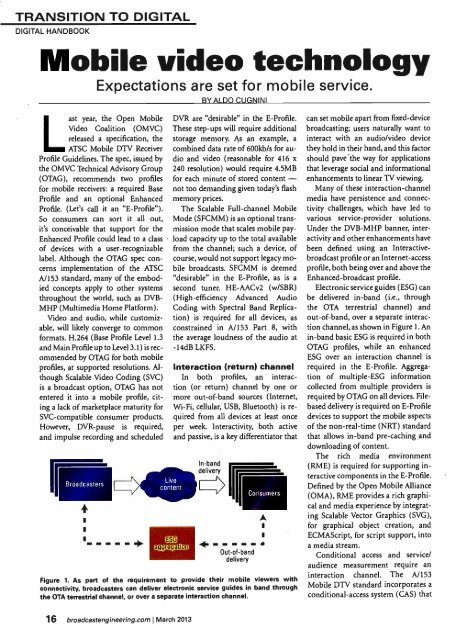ßroadcastEnsineerin - AmericanRadioHistory.Com
ßroadcastEnsineerin - AmericanRadioHistory.Com
ßroadcastEnsineerin - AmericanRadioHistory.Com
Create successful ePaper yourself
Turn your PDF publications into a flip-book with our unique Google optimized e-Paper software.
TRANSITION TO DIGITAL<br />
DIGITAL HANDBOOK<br />
Mobile video technology<br />
Expectations are set for mobile service.<br />
BY ALDO CUGNINI<br />
Last year, the Open Mobile<br />
Video Coalition (OMVC)<br />
released a specification, the<br />
ATSC Mobile DTV Receiver<br />
Profile Guidelines. The spec, issued by<br />
the OMVC Technical Advisory Group<br />
(OTAG), recommends two profiles<br />
for mobile receivers: a required Base<br />
Profile and an optional Enhanced<br />
Profile. (Let's call it an "E- Profile ").<br />
So consumers can sort it all out,<br />
it's conceivable that support for the<br />
Enhanced Profile could lead to a class<br />
of devices with a user -recognizable<br />
label. Although the OTAG spec concerns<br />
implementation of the ATSC<br />
A/153 standard, many of the embodied<br />
concepts apply to other systems<br />
throughout the world, such as DVB-<br />
MHP (Multimedia Home Platform).<br />
Video and audio, while customizable,<br />
will likely converge to common<br />
formats. H.264 (Base Profile Level 1.3<br />
and Main Profile up to Level 3.1) is recommended<br />
by OTAG for both mobile<br />
profiles, at supported resolutions. Although<br />
Scalable Video Coding (SVC)<br />
is a broadcast option, OTAG has not<br />
entered it into a mobile profile, citing<br />
a lack of marketplace maturity for<br />
SVC -compatible consumer products.<br />
However, DVR -pause is required,<br />
and impulse recording and scheduled<br />
Broadcasters<br />
1<br />
1<br />
1<br />
DVR are "desirable" in the E- Profile.<br />
These step -ups will require additional<br />
storage memory. As an example, a<br />
combined data rate of 600kb /s for audio<br />
and video (reasonable for 416 x<br />
240 resolution) would require 4.5MB<br />
for each minute of stored content -<br />
not too demanding given today's flash<br />
memory prices.<br />
The Scalable Full -channel Mobile<br />
Mode (SFCMM) is an optional transmission<br />
mode that scales mobile payload<br />
capacity up to the total available<br />
from the channel; such a device, of<br />
course, would not support legacy mobile<br />
broadcasts. SFCMM is deemed<br />
"desirable" in the E- Profile, as is a<br />
second tuner. HE -AACv2 (w/SBR)<br />
(High -efficiency Advanced Audio<br />
Coding with Spectral Band Replication)<br />
is required for all devices, as<br />
constrained in A /153 Part 8, with<br />
the average loudness of the audio at<br />
-14dB LKFS.<br />
Interaction (return) channel<br />
In both profiles, an interaction<br />
(or return) channel by one or<br />
more out -of -band sources (Internet,<br />
Wi -Fi, cellular, USB, Bluetooth) is required<br />
from all devices at least once<br />
per week. Interactivity, both active<br />
and passive, is a key differentiator that<br />
In -band<br />
delivery<br />
Out -of -band<br />
delivery<br />
Consumers<br />
Figure 1. As part of the requirement to provide their mobile viewers with<br />
connectivity, broadcasters can deliver electronic service guides in band through<br />
the OTA terrestrial channel, or over a separate interaction channel.<br />
1<br />
1<br />
can set mobile apart from fixed- device<br />
broadcasting; users naturally want to<br />
interact with an audio /video device<br />
they hold in their hand, and this factor<br />
should pave the way for applications<br />
that leverage social and informational<br />
enhancements to linear TV viewing.<br />
Many of these interaction- channel<br />
media have persistence and connectivity<br />
challenges, which have led to<br />
various service -provider solutions.<br />
Under the DVB -MHP banner, interactivity<br />
and other enhancements have<br />
been defined using an Interactive -<br />
broadcast profile or an Internet -access<br />
profile, both being over and above the<br />
Enhanced -broadcast profile.<br />
Electronic service guides (ESG) can<br />
be delivered in -band (i.e., through<br />
the OTA terrestrial channel) and<br />
out -of -band, over a separate interaction<br />
channel, as shown in Figure 1. An<br />
in -band basic ESG is required in both<br />
OTAG profiles, while an enhanced<br />
ESG over an interaction channel is<br />
required in the E- Profile. Aggregation<br />
of multiple -ESG information<br />
collected from multiple providers is<br />
required by OTAG on all devices. File -<br />
based delivery is required on E- Profile<br />
devices to support the mobile aspects<br />
of the non - real -time (NRT) standard<br />
that allows in -band pre- caching and<br />
downloading of content.<br />
The rich media environment<br />
(RME) is required for supporting interactive<br />
components in the E- Profile.<br />
Defined by the Open Mobile Alliance<br />
(OMA), RME provides a rich graphical<br />
and media experience by integrating<br />
Scalable Vector Graphics (SVG),<br />
for graphical object creation, and<br />
ECMAScript, for script support, into<br />
a media stream.<br />
Conditional access and service/<br />
audience measurement require an<br />
interaction channel. The A/153<br />
Mobile DTV standard incorporates a<br />
conditional- access system (CAS) that<br />
16 broadcastengineering.com I March 2013
















